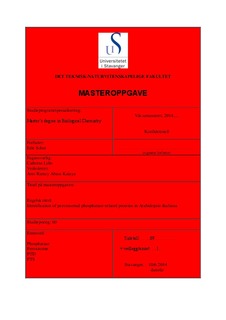| dc.description.abstract | Phosphorylation is a key regulatory mechanism in all aspects of plant biology, and protein phosphorylation is the most frequent post-translational protein modification. The complete genomic sequence of the model plant Arabidopsis thaliana enables an extensive exploration of the phosphatases encoded by this organism.
The Arabidopsis genome contains almost 300 genes that encode proteins containing either Peroxisomal Targeting Signal (PTS) type 1 or type 2. The identification of peroxisomal protein kinases, phosphatases and phosphorylated proteins strongly suggests that plant peroxisomal metabolism is regulated by reversible phosphorylation.
A selection of 9 peroxisome-predicted phosphatase related proteins from Arabidopsis thaliana were investigated by in vivo subcellular targeting analysis. The purpose was to determine if they did target to peroxisomes. The chosen proteins were Purple Acid phosphatase 7 (PAP7), Mitogen activated kinase phosphatase 1 (MapKP1), Pol-like phosphatase 2 (PLL2), Pol-like phosphatase 3 (PLL3), Trehalose-6-phosphat phosphatase 1 (TPP1-100), 2-phosphoglycolate phosphatase 1 (GLP1), TIP41-like family protein (TIP41), Shewanella-like protein phosphatase 1 (SLP1) and a protein of the Endonuclease/exonuclease/phosphatase family (8030). The first 7 proteins (PAP7, MapKP1, PLL2, PLL3, TPP1-100, TIP41 and GLP1) was predicted to hold a putative peroxisomal targeting signal type 1 (PTS1) at the C-terminal. The SLP1 and 8030 was predicted to contain a putative PTS2 near the N-terminal.
Enhanced Yellow Fluorescence Protein (EYFP) was fused to the putative Peroxisomal Targeting Domain (PTD) of the investigated proteins. The constructs were transiently transformed into epidermal onion cells using a biolistic gene-gun and to Arabidopsis mesophyll protoplasts using PEG-transformation. The expression of the construct was examined using inverted fluorescence microscopy. As the PTS1 is the same in PLL2 and PLL3 a total of 8 PTD constructs was made. Out of these 8 PTD constructs, 5 showed to be targeted to peroxisomes. All the peroxisomal PTDs hold a putative PTS1-signal. The proteins with a PTD1 found in peroxisomes were PAP7, MapKP1, PLL2&3, TPP1-100 and TIP41. The last PTS1 predicted protein, as well as the 2 proteins predicted to hold a PTS2, were not found in peroxisomes.
Full-length constructs of 5 of the proteins tagged with EYFP were examined, and 2 were found in peroxisomes. The three proteins found in peroxisomes was Purple acid phosphatase 7 (PAP7) and Trehalose-6-phosphat phosphatase (TPP1-100) .Even though several following-up experiments should be conducted and some full-length phosphatase-constructs were not finished during the time-span of this thesis, the experiments performed during this work shows that phosphatases probably are a part of the regulatory system of peroxisomal metabolism. | nb_NO |
